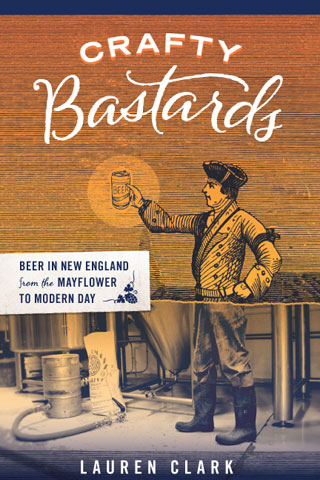October 21st, 2009
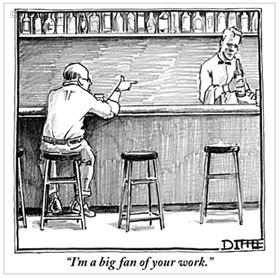 Shoot, y’all. Some mighty fancy folk are making their way to ol’ Beantown to open up swanky bars in a pair of purty new hotels.
Shoot, y’all. Some mighty fancy folk are making their way to ol’ Beantown to open up swanky bars in a pair of purty new hotels.
First, the W Boston in the theater district. Come October 29, its “decadent indulgences await your exploration, immersion, savoring, lingering, mingling, socializing, canoodling and celebrating.” Lingering? Mingling? OK. But canoodling? We don’t do that in Boston! Irregardless, Sasha Petraske, well known in cocktaildom for opening Milk & Honey (the bar that launched 1,000 speakeasies), Little Branch and Dutch Kills in New York and the Varnish in L.A., is reportedly in charge of the cocktail menu at the W Boston’s “destination bar.” (Update: that bar, called Descent, will not open until early 2010.)
Meanwhile, John Lermayer, who leapt from head bartender at the Florida Room in Miami’s Delano Hotel to internationally acclaimed mixologist, is helming the booze program at Woodward, a “modern day tavern” in the Ames Hotel, which opens in the financial district November 19. Woodward’s PR says that Lermayer and William “English Bill” Codman (a longtime Boston bartender) are developing a “distinctive drinks menu featuring modern touches on beloved classics such as a Margarita infused with chamomile agave nectar and a Caipirinha with local apple cider and fresh rosemary.”
Neat.
OK, these are talented guys who no doubt can write an impressive cocktail menu. But, once they leave town, who (besides Codman at Woodward) will turn their recipes into drinkable drinks? That’s the million-dollar question (no exaggeration). We all know that a bad performance can turn Shakespeare into crap. Cocktail lists in certain places around town look good until you actually order from them. Take the Back Bay’s new Post 390. They serve Sazeracs! … in snifters … without a discernable trace of Peychaud’s bitters. Sigh.
But rather than be cynical, I’m going to view this as a potential bonanza for Boston bartending. So many openings for skilled practitioners all of a sudden — where will they come from? Will they be pilfered from other high-end bars like Drink, Eastern Standard, No. 9 Park and Craigie on Main? Or will ‘tenders who already man the planks at Boston’s finest hotels and steak houses gravitate to the Ames and the W to learn top-notch mixology? Should be interesting.
And think about it, aspiring bartenders: we’re still in the midst of the Great Recession, yet quality bars in Boston aren’t just booming, they’re proliferating. I mean, Legal Sea Foods is getting in on the game, for chrissake. Get yourself started as a bar back and look toward a rosy future — Boston imbibers need you!
Permalink | 12 Comments | Filed under Bartenders, Boston bars, Cocktails | Tags: Ames, hotel bars, John Lermayer, Sasha Petraske, W, Woodward
October 16th, 2009

Bloggers have arrived. It’s true, because the Federal Trade Commission recently decided to impose rules on us. All together now: Wooo … hey, wait a minute!
Starting December 1, bloggers, and even users of Twitter and Facebook, “who review products must disclose any connection with advertisers, including, in most cases, the receipt of free products and whether or not they were paid in any way by advertisers, as occurs frequently,” reported the New York Times. “For bloggers who review products, this means that the days of an unimpeded flow of giveaways may be over. More broadly, the move suggests that the government is intent on bringing to bear on the Internet the same sorts of regulations that have governed other forms of media, like television or print.”
Hmmm, where to start. Disclosure? Well of course people should disclose when they’re compensated for endorsing stuff. But what is “compensation?” What is “endorsing?” Do I have to spell out that free booze is involved whenever I write about a promotional event hosted by a liquor company? Then there are product reviews. Those aren’t generally my game, but, given that this is a blog about drinking, I do discuss products from time to time — products I’ve paid for and products I haven’t. In this review of ri(1) whiskey, was it enough to disclose that I got a bottle of the stuff in the mail and let readers make the assumption? Or do I have to come right out and say that it was a gift, or, let’s cut to the chase, a bribe? Does the fact that I didn’t exactly endorse the whiskey count for anything? Or does merely devoting a post to it mean that I’m promoting it? Can you say can o’ worms?
The FTC ruling is aimed partly at celebrity bloggers who don’t disclose their ties to companies. Fair enough. But most bloggers aren’t celebrities, and I’m guessing most would laugh at the notion that they’re recipients of “an unimpeded flow of giveaways.” Certainly, there are bloggers out there who act as stealth spokesmen. I’ve been approached by some small companies — you know, people who make novelty coasters and stuff — asking if I’d write a positive review of their products in exchange for a little cash. Ewww. Like I’m going to whore myself out to these guys for $50. But some people do just that, or such solicitations wouldn’t exist. The thing is, it’s pretty easy to ID the bloggers who are only in it for free product — their blogs are boring, and no one reads them.
The other issue here is, are bloggers and the rest of the social media world being unfairly singled out? Some people think so. But … don’t the FTC’s rules about deceptive advertising practices apply to other forms of media? That’s why movie producers are always getting slapped with big fines for product placement in their films, and travel writers are punished for free hotel-room stays, and the beer newspaper I once wrote for was ordered to cease and desist the practice of taking free samples of IPA.
Right.
So why make a point of applying the rulebook to social media without renewing the commitment to crack down on pay-for-play in the traditional media? Because, as the Times article points out, “sites like Twitter and Facebook, as well as blogs, have offered companies new opportunities to pitch products with endorsements that carry a veneer of authenticity because they seem to be straight from the mouth — or keyboard — of an individual consumer.” In other words, it’s worse to be deceived by a close friend than by a stranger.
Very few social media mavens are losing sleep over any of this, of course. I mean, besides the fact that there are a couple hundred million of us for the FTC to monitor, we realize that the regulators are lagging adorably behind reality. Sure, a few people have no doubt been tricked into buying Nikes because some celeb got paid to blog about sneakers. But the online world evolves quickly, and, personally, I think its denizens are more savvy than they get credit for. Plus, if the feds came after me for not disclosing that those drinks I had at the Grand Marnier party were free, I’d gain such notoriety that I probably could get an endorsement deal. Hello, Beefeater?
Permalink | 9 Comments | Filed under Booze in the news | Tags: advertising, bloggers, FTC, social media
October 9th, 2009
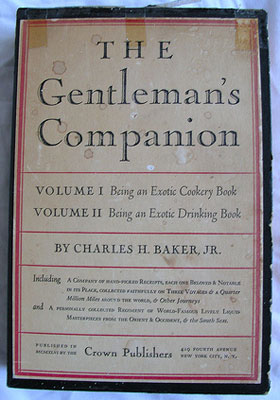 Earlier this year, Nightclub & Bar magazine published an article I wrote on the resurgence of vintage cocktail books and the bartenders who love them called Tools of the Trade: Jiggers, Shakers and Out-of-Print Books. This was just after Mud Puddle books, the EUVS (Exposition Universelle des Vins et Spiriteux) and others became known for reissuing these obscure, old volumes, whose original editions had been selling for crazy money online. We have crossed over to a new world now — a world in which David Embury’s The Fine Art of Mixing Drinks and Harry Johnson’s Bartenders’ Manual and Guide for Hotels and Restaurants can be had for the price of a couple of cocktails, if not entirely free.
Earlier this year, Nightclub & Bar magazine published an article I wrote on the resurgence of vintage cocktail books and the bartenders who love them called Tools of the Trade: Jiggers, Shakers and Out-of-Print Books. This was just after Mud Puddle books, the EUVS (Exposition Universelle des Vins et Spiriteux) and others became known for reissuing these obscure, old volumes, whose original editions had been selling for crazy money online. We have crossed over to a new world now — a world in which David Embury’s The Fine Art of Mixing Drinks and Harry Johnson’s Bartenders’ Manual and Guide for Hotels and Restaurants can be had for the price of a couple of cocktails, if not entirely free.
Much like I did with Boston-area bartenders a while back, I got in touch with a bunch of bartenders nationwide about their favorite old cocktail and bartending books, and whether they had ever spent big bucks on a must-have, brittle-paged tome of yore. Only tiny bits of their entertaining and thoughtful responses made it into the article. So, like any good blogger, I present here some outtakes, in no particular order, that didn’t make it into print. One thing that’s clear in both the print piece and the commentary below: everyone loves Charles Baker’s The Gentleman’s Companion, Vol. II (1939). But not for the recipes.
(The Gentleman’s Companion, Vol. II was republished in 1992 as Jigger, Beaker and Flask: Drinking Around the World. Most of Mud Puddle’s books can be found locally at the Boston Shaker.)
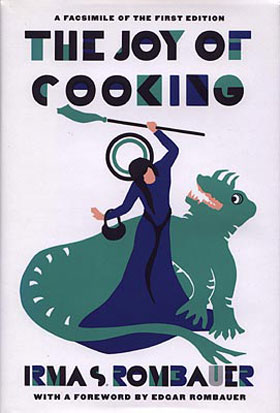 Stephen Cole, Violet Hour, Chicago
Stephen Cole, Violet Hour, Chicago
To be honest, my favorite cocktail books are old cookbooks. Back then they had to plan entire parties just from one book — all the way from pairing the wine with the meal, bottle service, table set-up, carving out blocks of ice for punches, and even how to take down a whole cow from the field to the table. With my background of cooking for about 10 years, it was fun to go back to these old books that I had for that, and find traces of punch recipes from [Jerry] Thomas himself. I say the Joy of Cooking, by Rombauer (1931).
Alex Day, Death + Company, New York
I should probably give you a general impression of how I feel about vintage cocktail books. I consider myself a professional bartender and am very passionate about what I do, but I’ve been eyeing the craze toward snatching up vintage cocktail books with a bit of skepticism. To me, the trend likens itself more toward the trappings of specific, hard-to-find antiques than it does to actually serving customers and expanding one’s craft.
And then there’s getting all sociological with this. American bartenders are constantly being told that our heritage and heyday lie in pre-Prohibition cocktails, and that the time between the Great Experiment and the recent classics revival has been marred by crap. We find ourselves looking back desperately to a time when the barman deserved the respect and admiration of his community and patrons, so I think there’s a real need to acquire these books to, in a way, legitimize what we’re doing with this revival.
For me, the absolute best vintage cocktail book in my collection is Charles H. Baker, Jr.’s The Gentleman’s Companion. Would I ever use a recipe from this book? No way. For me, the magic is in the writing and the story telling. What I have personally gotten from this book? A more relaxed approach to cocktails. An ethos that says: this is just cocktails. Sure, they’re damn good cocktails, but really, we’re here in this bar enjoying our lives, enjoying the people in our lives, enjoying the spirits in our glass, and enjoying the world.
Joaquin Simo, Death + Company, New York
My favorite is probably Charles H. Baker Jr.’s Gentleman’s Companion and his South American Gentleman’s Companion. While there are certainly some diamonds in the rough to be found recipe-wise, the real pleasure of reading those books lies in his inimitable prose. He drank with the best writers of his time and was surely their equal behind a typewriter as well as behind the stick.
Josey Packard, Drink, Boston
[While working for the Alembic bar in San Francisco], I looked on web sites that specialize in antiquarian books for Thomas’s How to Mix Drinks and found that at that time the first and second editions were going for around $1000. But one search — on half.com of all places — showed that among the slew of recently published ones for around $15, there was a seller listing one at $200. He mentioned some cover wear and pencil marks, and I just had a feeling about it — that he had an old one and had misunderstood how to list it properly. What came was the 1876 second edition, with some worm damage on the spine but otherwise in excellent shape. I held it and held it and held it, and ultimately sold it to Alembic for the purchase price, as my overdeveloped sense of morality told me that because I was searching on Alembic’s behalf at the time they should get it. I still feel ambivalent about it, though it is a real centerpiece of their library and is a real feather in their cap.
As pedestrian as it sounds, I keep coming back to the Savoy Cocktail Book (1930). Its completeness is unparalleled, though I almost never use the recipes as they don’t tend to be delicious as listed. The most beautiful book I own is Still Life With Bottle: Whisky According to Ralph Steadman (1997). The most useful book, being the book that taught me what I knew nothing about, is Folk Wines, Cordials, and Brandies by M. A. Jagendorf (1963). The most unusual, yet useful, cocktail history book I have is Convivial Dickens by Edward Hewett and W. F. Axton (1983), in which all of the instances in which Dickens mentions or describes drinking in his fiction are extrapolated and explained, with modern equivalents for recipe experimentation. If a person is to have one cocktail book, and only one, I’d pick Joy of Mixology (2003). The graph section is the most useful innovation I’ve yet seen in helping people understand how drinks are related.
Jeffrey Morgenthaler, Portland, OR
[After Baker], the second book I pick up more than just about any other is not neccessarily vintage, but certainly rare and very much out of print. That book is called Cocktail: The Drinks Bible for the 21st Century, by Paul Harrington. This may very well be the most influential writing for me, as Harrington’s philosophies about cocktails most closely reflect my own. I know it’s only about 10 years old, but it’s quite rare and very much prized, especially among bartenders.
I haven’t spent a great amount of money on any one book — I’m too much of a bargain hunter to put up with that. I’m also a total douchebag, so I like to scour the mom-and-pop used bookstores in small towns around Oregon, picking up gems for a song while they’re none the wiser. At least I never sell them for a profit. I did get into an all-out bidding war for an early edition of The Old Waldorf-Astoria Bar Book many years ago and can’t help but think that other person is now one of my friends, Paul Clarke or something.
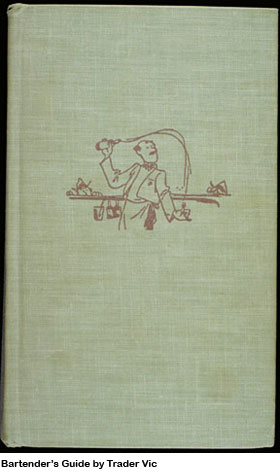 Marcos Tello, The Edison, The Varnish, L.A.
Marcos Tello, The Edison, The Varnish, L.A.
I actually have three favorites: Bartender’s Guide by Trader Vic (1947) — the recipes in this book are very similar to the modern breakdown of “classic” cocktails that many use today; Bottoms Up by Ted Saucier (1951) — there are a lot of great cocktails in this book, especially cocktails that originated from California; and the lesser known Home Made Beverages by Albert Hoskins (1891) — this book is a complete encyclopedia of syrups, phosphates, bitters, etc.
Kirk Estopinal, Cure, New Orleans
Charles Baker’s Gentleman’s Companion series. I know everyone loves this one, but as a read it really brings you into a high-minded, romantic setting of drinking in the days of old. Verbose as Zelda Fitzgerald and humorous as the small fraction of good stand-up comedy. The needle in the haystack of cocktail guides.
Partick Gavin Duffy’s Official Mixers Manual (1934). The intro itself is enough to make me love this book: “Bartending is an honorable trade. It is not a profession, and I have no sympathy with those who try to make it anything but what it was. The idea of calling a bartender a professor or a mixologist is nonsense.” YIKES! This guy is pissed off at someone. The recipes are fantastic, though — actually functional, unlike some other classic “guides.” Cool glassware diagrams as well as all drinks coded with their corresponding glass. I bet Wondrich likes this guy.
Esquire’s Handbook for Hosts (1949). Hundreds of recipes that mostly work. Serves as connective tissue for someone looking for the lineage of classics. The illustrations are a plus. And the overall idea that this is a guide to throw parties, down to tone of voice and what not to say in mixed company. Civility with a little sexism — a look back into the mindset of old.
Ted Haigh, aka Dr. Cocktail, L.A.
I have a number of favorite cocktail books, though some of my faves have changed over time. Generally there is a specific characteristic of each beloved tome that hoists it up on my dais.
For the shear joy of recapturing a past era’s less-traveled wonder at far away places with their strange-sounding names, I think all drink nerds will point definitively at Chas. Baker. It is mixology-as-literature, just as Hemingway is literature-as-mixology. I seldom make drinks from it — it is very uneven in that regard — but as a sip inducer, it sets the mood like no other.
For inspiration courtesy of the best layout any cocktail book ever had, I go with an obscure little book named The How and the When by Hyman Gale, a bar guide first published in Chicago in 1937. Contrary to conventional wisdom, this is no wonderland of graphical grace like Harry Craddock’s Savoy Cocktail Book, or a gilt-edged beauty like Cocktail Fashions of 1936. It is printed on semi-gloss coated stock, with black ink, devoid of any decoration. What makes this book such an unduplicated joy to use are the concise two columns of recipes in simple type on each page. No hyperbole, no flourishes, just a drink’s title in one font larger, and a clear, easy to read recipe in smaller simple serif type below it. This is a book to ponder recipes in. They may have been published elsewhere first, but this is my favorite wellspring for their rediscovery.
 I’ve been at the forgotten cocktail game for a long time. As such, my go-to sources for unrevived cocktails change over time. Currently, I have three. One is nearing the end of its reign at the top, one is front and center, and one has only begun to be tapped. In that order, they are: Barflies & Cocktails by Harry McElhone (where I lavish my attention on the section of drinks about town by Arthur Moss). The next is the Waldorf Bar Book by Albert Stevens Crockett. Here you get a half-book narrative of old New York, and half recipes. Of those recipes, a vast number would today be considered variations (minute variations) on the classic Martini. Gin, vermouth (or none,) bitters (or none), where the entirety of the differentiation is in proportion, brand, type and, of course, name. These recipes, frankly, make this a hard book to browse with much enthusiasm, but the great secret is that, excluding those recipes, many of the rest are strictly uncommon and startlingly good. And the newcomer in this category is… Modern American Drinks by George Kappeler. To taste the 19th century, this is where I am beginning to turn. Of the books I cite, this one, from 1895, is the oldest yet.
I’ve been at the forgotten cocktail game for a long time. As such, my go-to sources for unrevived cocktails change over time. Currently, I have three. One is nearing the end of its reign at the top, one is front and center, and one has only begun to be tapped. In that order, they are: Barflies & Cocktails by Harry McElhone (where I lavish my attention on the section of drinks about town by Arthur Moss). The next is the Waldorf Bar Book by Albert Stevens Crockett. Here you get a half-book narrative of old New York, and half recipes. Of those recipes, a vast number would today be considered variations (minute variations) on the classic Martini. Gin, vermouth (or none,) bitters (or none), where the entirety of the differentiation is in proportion, brand, type and, of course, name. These recipes, frankly, make this a hard book to browse with much enthusiasm, but the great secret is that, excluding those recipes, many of the rest are strictly uncommon and startlingly good. And the newcomer in this category is… Modern American Drinks by George Kappeler. To taste the 19th century, this is where I am beginning to turn. Of the books I cite, this one, from 1895, is the oldest yet.
Yet, there is one older… my final fave. The vastly-titled New Guide for the Hotel, Bar, Restaurant, Butler & Chef by “Bacchus & Cordon Bleu” wins my quirkiest oddball drink book award. I’ll assert it is also the progenitor of that category. You see, not only does one make drinks from the recipes in this 1885 book, one makes the liqueurs — potions, really — that go into those drinks. No drink guide has ever been so arcane. So if you fancy a beverage prepared with Liqueur Excelsior, or perhaps Liqueur Criterion, this is where you must turn.
Permalink | 4 Comments | Filed under Bartenders, Books & resources | Tags: Charles Baker, David Embury, Harry Johnson, Irma Rombauer, Jerry Thomas, Trader Vic, vintage cocktail books
October 3rd, 2009
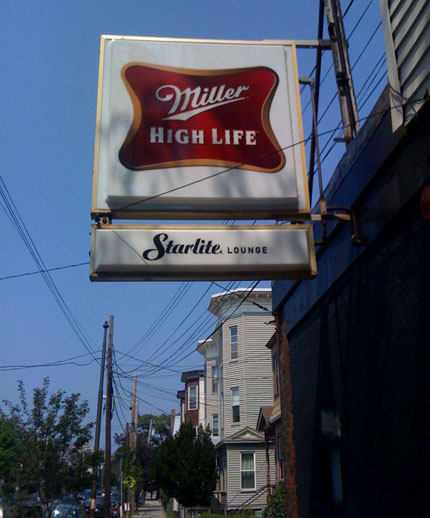
» The biggest news for this installment of Nips is the opening of a fun, new neighborhood bar: Trina’s Starlite Lounge in Inman Square, Cambridge (in the former home of the Abbey Lounge — R.I.P.). If the Starlite were a film, its opening weekend would make it a blockbuster. My preliminary review: energetic, funky vibe; a bar and management staff full of heavy hitters who balance skills with a good-time attitude; a somewhat spare-despite-its-retro-decor look; a very wallet-friendly menu of American picnic ‘n’ patio fare; a list of classic- and culinary-inspired cocktails that’s decent but doesn’t knock my socks off (although a rye Manhattan with Carpano Antica did); and a puzzlingly suburban beer list (Coors Light? Blue Moon? However, Reading Lager in cans and a bucket of High Life ponies are a nice touch).
» Two very different booze promotions rolled through town recently. One was for Grand Marnier, at Drink. The other was for The Macallan, at the Cyclorama.
Jeff Grdinich, New Hampshire barman and consultant with aka wine geek (which represents GrandMa), enlisted bartenders/mixologists around Boston to create cocktails featuring the sweet, cognac-based orange liqueur. Basically, GrandMa’s like, ‘Hey, all the cocktail geeks are mixing with Cointreau — we want a piece of the action, too.’ It’s true that a lot of vintage cocktail recipes call for the less syrupy Cointreau for orange flavor. But the mixologists stepped up, and the drinks at this party were for the most part tasty and balanced. I’m partial to one that I’ve written about before: Grdinich’s Root of All Evil. Also check out Cocktail Virgin Slut’s assessment of not only their own Lioness (of Brittany) but also Scott Holliday’s Alicante, Matt Schrage’s Hugo Ball and John Gertsen’s Mission of Burma. Interesting stuff.
Where the GrandMa event was a mingle-friendly, French-themed cocktail fête (co-organized by the saucy broads of LUPEC Boston), the Macallan event was a slick presentation, complete with pulsing club music and moody, black-and-white images of a nude model posing among barrels of aging scotch. Not what I expected, to say the least. Brand ambassador Graeme Russell, whose red tartan pants accented the bizarro atmosphere, told the 150 or so guests about the distillery’s history and methods, including its unusually small copper pot stills and predominant use of sherry barrels (as opposed to bourbon barrels). He talked us through tastes of the 12-, 15-, 17- and 18-year-olds, with the latter two being the most impressive (they retail for about $120 and $150, respectively). The 18-year, aged entirely in sherry barrels, was an ethereal balance of honey, flower and orchard fruit notes with just enough smoke to let you know you were drinking scotch. The 17 was earthier, with an acidic, phenolic character coming from a portion of whiskey that had been aged in bourbon barrels, which are more charred than sherry barrels and produce bolder flavors. Great scotch, weird presentation.
» And now for some literature… Finally, a useful dictionary. Drunk: The Definitive Drinker’s Dictionary just came out, with a record 2,964 terms for, ya know, blotto, plastered and Dean Martoonied. There’s a companion website, too. Once you’ve purchased the tome online, check out Wayne Curtis’ astute, witty profile in Downeast magazine of a Portland, ME, bartender who badly needed profiling: John Myers. We see Myers’ “Wild Bill Hickok” demeanor around Boston now and again, but not enough. Finally, you’re well aware that a brewer for Guinness perfected a statistical method called “small sample theory” in the early 1900s, thus ushering in the modern capability of brewers and other manufacturers to produce tons of product and produce it consistently, right? Oh, you’re not? Well, read this Salon post about how the human thirst for alcohol can lead to great scientific advances.
Permalink | 3 Comments | Filed under Books & resources, Boston bars, Liqueur, Whiskey | Tags: drunk dictionary, Grand Marnier, Macallan, Trina's Starlite Lounge
September 30th, 2009
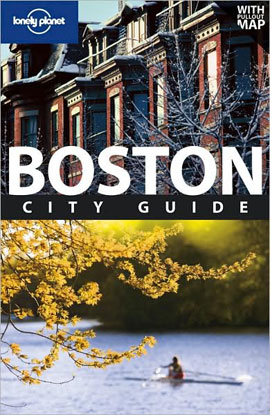 I’ve used Lonely Planet’s travel guides on various trips, but never have I actually appeared in/written for one — until now.
I’ve used Lonely Planet’s travel guides on various trips, but never have I actually appeared in/written for one — until now.
Mara Vorhees, a Somerville resident who wrote the 2009 edition of Lonely Planet’s Boston City Guide, cold-called drinkboston a little while ago to see if I wanted to write a sidebar for the guide’s Drinking section. Uh, does a cold martini taste good at 5:00 p.m? Called “The ‘Boston’ Cocktail Mystery,” the sidebar riffs off of a post I once wrote about the curious hodgepodge of vintage cocktails with “Boston” in their name. Mara was also nice enough to mention me in the section’s intro as an expert on the local drinking scene. Neat.
There’s a lot of good stuff in this guide, even if you’re a local. For $17.99, it’s worth keeping around the house for when out-of-towners come to visit. Especially if they happen to be fond of drink.
Permalink | 9 Comments | Filed under Books & resources, drinkboston in the news | Tags: lonely planet, travel
 Shoot, y’all. Some mighty fancy folk are making their way to ol’ Beantown to open up swanky bars in a pair of purty new hotels.
Shoot, y’all. Some mighty fancy folk are making their way to ol’ Beantown to open up swanky bars in a pair of purty new hotels.
 Earlier this year, Nightclub & Bar magazine published an article I wrote on the resurgence of vintage cocktail books and the bartenders who love them called
Earlier this year, Nightclub & Bar magazine published an article I wrote on the resurgence of vintage cocktail books and the bartenders who love them called  Stephen Cole, Violet Hour, Chicago
Stephen Cole, Violet Hour, Chicago Marcos Tello, The Edison, The Varnish, L.A.
Marcos Tello, The Edison, The Varnish, L.A. I’ve been at the forgotten cocktail game for a long time. As such, my go-to sources for unrevived cocktails change over time. Currently, I have three. One is nearing the end of its reign at the top, one is front and center, and one has only begun to be tapped. In that order, they are: Barflies & Cocktails by Harry McElhone (where I lavish my attention on the section of drinks about town by Arthur Moss). The next is the Waldorf Bar Book by Albert Stevens Crockett. Here you get a half-book narrative of old New York, and half recipes. Of those recipes, a vast number would today be considered variations (minute variations) on the classic Martini. Gin, vermouth (or none,) bitters (or none), where the entirety of the differentiation is in proportion, brand, type and, of course, name. These recipes, frankly, make this a hard book to browse with much enthusiasm, but the great secret is that, excluding those recipes, many of the rest are strictly uncommon and startlingly good. And the newcomer in this category is… Modern American Drinks by George Kappeler. To taste the 19th century, this is where I am beginning to turn. Of the books I cite, this one, from 1895, is the oldest yet.
I’ve been at the forgotten cocktail game for a long time. As such, my go-to sources for unrevived cocktails change over time. Currently, I have three. One is nearing the end of its reign at the top, one is front and center, and one has only begun to be tapped. In that order, they are: Barflies & Cocktails by Harry McElhone (where I lavish my attention on the section of drinks about town by Arthur Moss). The next is the Waldorf Bar Book by Albert Stevens Crockett. Here you get a half-book narrative of old New York, and half recipes. Of those recipes, a vast number would today be considered variations (minute variations) on the classic Martini. Gin, vermouth (or none,) bitters (or none), where the entirety of the differentiation is in proportion, brand, type and, of course, name. These recipes, frankly, make this a hard book to browse with much enthusiasm, but the great secret is that, excluding those recipes, many of the rest are strictly uncommon and startlingly good. And the newcomer in this category is… Modern American Drinks by George Kappeler. To taste the 19th century, this is where I am beginning to turn. Of the books I cite, this one, from 1895, is the oldest yet.

